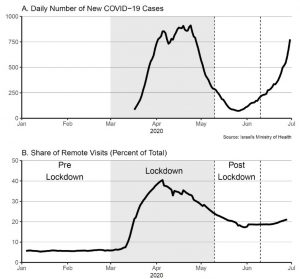Written by: Nevada Yahchouchi
Reading time: 7 minutes
What women need to know about telemedicine
More and more we see the world becoming more digitalized than ever before, therefore it also offers new opportunities for the healthcare industry, as this is an important topic to be addressed for everyone. There’s an exponential growth in applications that companies are offering in terms of virtual care, so what that means is; you can sit in the comfort of your own home, have access to a virtual physician and get medication sent to your home. So the question is; can we as consumers consider telemedicine/telehealth, as equal to care as usual? There are circumstances where you can, however, there are many circumstances where you cannot, and you may end up with delays, wrong diagnoses, and incomplete inaccurate care.
Who is the target audience for telemedicine?
More than 60% of its users are women between 25 and 44 year old, According to MAVEN; a leading organization in empowering and improving women’s and family health care in times of challenge and crises. Almost three million women have left the workforce since February of 2022, according to the department of labor. Women are also dealing with higher rates of burnout, depression, and anxiety, driving them off the career track. Employers can use telehealth benefits to prevent long-term consequences relating to poor mental health and care responsibilities impacting women and their families. ‘Telehealth benefits help women prioritize their health and well-being’ – according to Kate Ryder, CEO of Maven.

Number of Telehealth Claims, Jan 2019 t0 2020.
During the peak of the COVID-19 pandemic, the use of telehealth increased by 1,015% in total 46% used it for a single visit, 80% did not have more than four visits, and 14% had seven or more visits. The report according to the trilliant health report shows that women made up 60% of all telehealth patients. Women also made up the majority of each utilization group, which includes single users (one visit), low users (two to four visits), average users (five to six visits), high users (seven to 24 visits), and super users (25-plus visits). Among the female patients using behavioral health services for telehealth, the most common conditions were those related to stress and anxiety.
Telehealth or traditional health care?
“The data suggests that in the absence of alternative choices, telehealth appears to be a substitute good,” said Sanjula Jain, Ph.D., Trilliant Health’s chief research officer and senior vice president of market strategy. “However, when given a choice, the majority of patients prefer in-person care with the exception of behavioral health. Ultimately, traditional providers are not motivated to adopt telehealth and are not equipped to compete with retail suppliers.” Due to the well-defined population that seems to engage in telehealth, many providers and clinics may have difficulty maintaining telehealth services following the COVID-19 pandemic. The temporary increase in telehealth use during the pandemic was likely due to a lack of choice rather than preference, report authors stated.

Pre-Lockdown & Post-Lockdown
Why telehealth is the future?
Although many patients prefer clinical visits, telemedicine/telehealth is certainly a future possibility:
- Telehealth services are as good as those provided in traditional in-person consultations. In some specialties, particularly in mental health and ICU care which delivers a superior product, with greater outcomes and patient satisfaction.
- Virtual care technology saves patients time and money,especially to women, reduces patient transfers, emergency department and urgent care center visits, and delivers savings to payers.
- The use of telemedicine has been shown to allow for better long-term care management and patient satisfaction; it also offers a new means to locate health information and communicate. (via e-mail, video,..)
- Telemedicine is an exciting technology and continues to hold the promise of Being truly transformational in terms of healthcare delivery to everyone’s benefit. As the population continues to grow at a rate faster than the growth in The number of available qualified clinicians and facilities (institutional beds, investigation laboratories, day-care centres…), this technology will ensure that all those who need care are catered to standard acceptable levels, if not the best possible.

Telemedicine and Women – Photo by Ani Kolleshi
In fact; one of the United Nations Sustainable Development Goals (SDG’s) is related to global health, which was the initial purpose of writing this article in which the link between ‘telemedicine and SDG’s’ will be covered in more detail in the following articles. But for the sake of this article; how so? One of the SDGs refers to Sustainable Development Goal 3: Good Health and Wellbeing: ‘Ensure healthy lives and promote well-being for all at all ages’. The SDG declaration emphasizes that to achieve the overall health goal, ‘we must achieve universal health coverage (UHC) and access to quality health care. No one must be left behind’, as we all deserve to live a healthy happy life, telemedicine/telehealth can support that statement.

Nevada Yahchouchi Content Creator: International Business
Nevada is a young professional passionate about Enterpreneurship, women empowerment and human rights. She holds a bachelor’s degree in Economics and a Master’s degree in International Economics and finance at the Lebanese University. In her organisation role she contributes to Enterpreneurship, business and youth empowerment, in particular to the achievement of the UN sustainable development goals. She joined CoSE in 2022 as a content creator to write articles about these topics in order to raise awareness and bring her generation closer to the idea of creating the life they want, make them part of active change and pushing them to embark on the journey to feel passionate about.

